How to Derive Formulas of Tenses
We use was, were + ing in Past Continuous Tense. But where does this was, were come from? or ing come from. Students do not know the basics or origin of was, were + ing and have crammed this formula of Past Continuous and remaining other tenses. To get rid of this problem of cramming the formulas they themselves can drive or form formulas of the tenses from their names by using a simple syntactical technique and they will find out from where this was, were + ing come from. This will also help them understand tense of a sentences and your general understanding of English grammar will also improve. You will be able to build your own sentences, recognize the tense of written and spoken sentences and spot errors made by you in your own writings.
First of all, we have to understand the table below where first we see three forms of verb to be and has, have. In order to learn this method one must know was, were and been are 2nd and 3rd forms of to be and had is 2nd and 3rd form of has, have.


Second, there are values where present is equal to first form, past is equal to second form, future is equal to shall, will + 1st form and so on. Let's start from Present Continuous Tense and see how it works.
Present Continuous
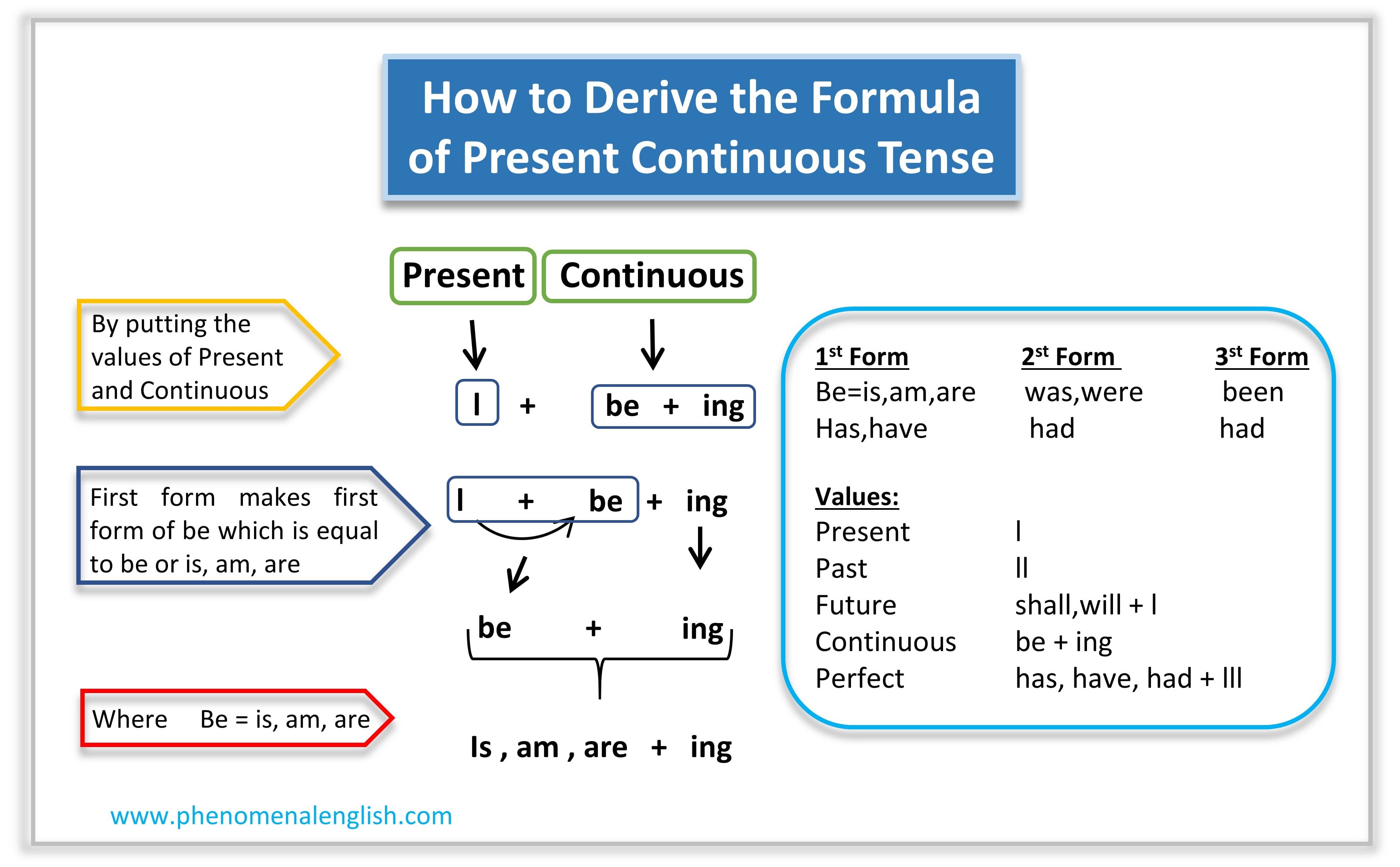

Explanation
First, we shall put values of present and continuous as are shown in the picture under the values heading where present is equal to 1st form and continuous is equal to be + ing. In the second step, 1st form will affect be and it makes 1st form of be which is be. "ing" will not be affected by any form so it remains same. In the third step the equation will be "be + ing" where be is equal to ia, am, are so whole formula will be "is, am, are + ing" which we use for Present Continuous Tense. In this way we can derive formula of any tense.
Past Continuous
For Past Continuous Tense same procedure will be repeated.
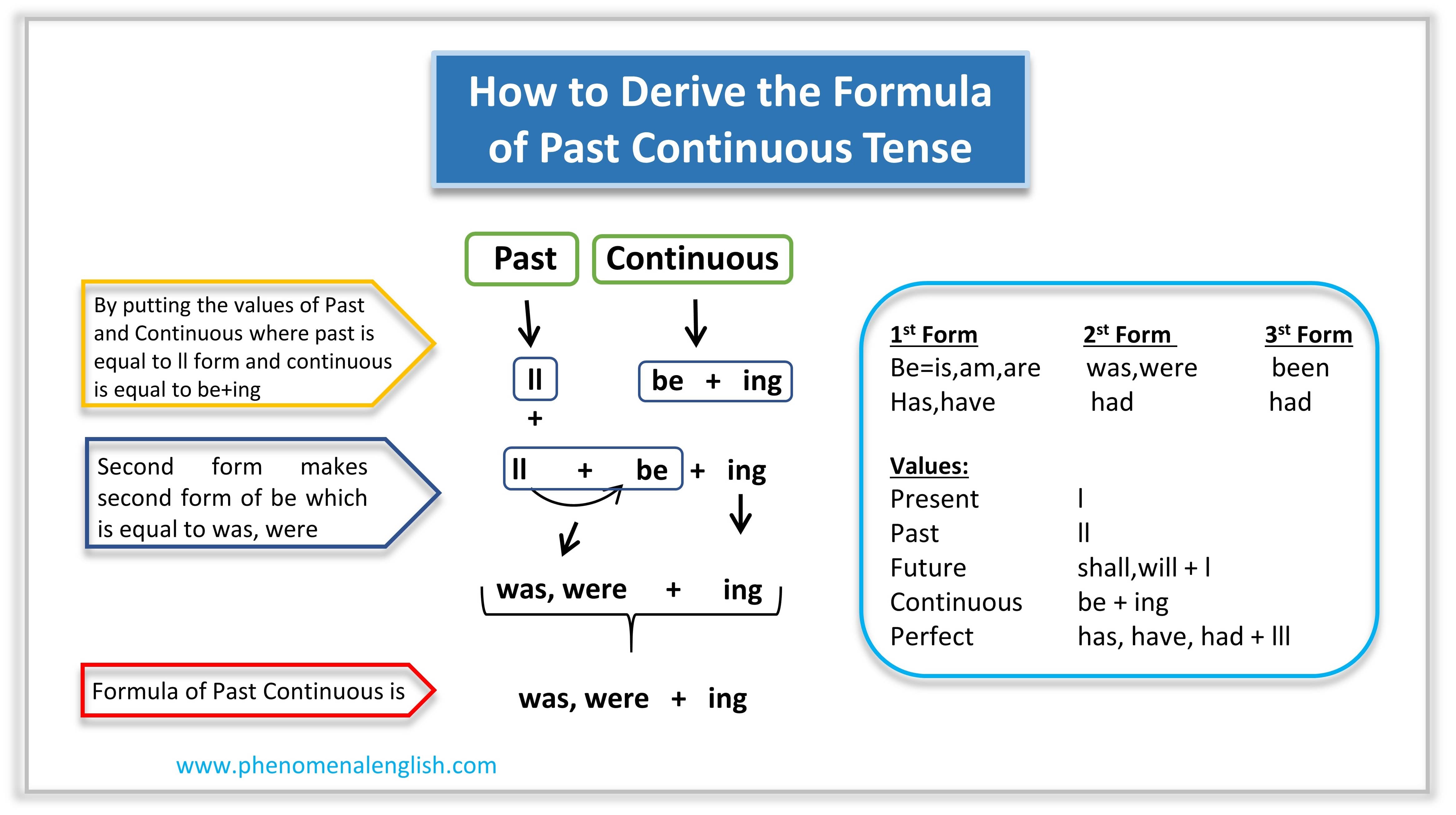

Explanation
First, we shall put values of past and continuous as are shown in the picture under the values heading where past is equal to 2nd form and continuous is equal to be + ing. In the second step, 2nd form will affect be and it makes 2nd form of be which is was, were. "ing" will not be affected by any form so it remains same. In the third step the equation will be "was, were + ing". So whole formula will be "was, were + ing" which we use for Past Continuous Tense.
Future Continuous


Explanation
We shall put values of future and continuous as are shown in the picture under the values heading where future is equal to shall, will + 1st form and continuous is equal to be + ing. In the second step, 1st form will affect be and it makes 1st form of be which is be. "ing" will not be affected by any form so it remains same. In the third step the equation will be "be + ing". Where be is equal to is, am, are. So whole formula will be "is, am, are + ing" which we use for Future Continuous Tense.
Present Perfect
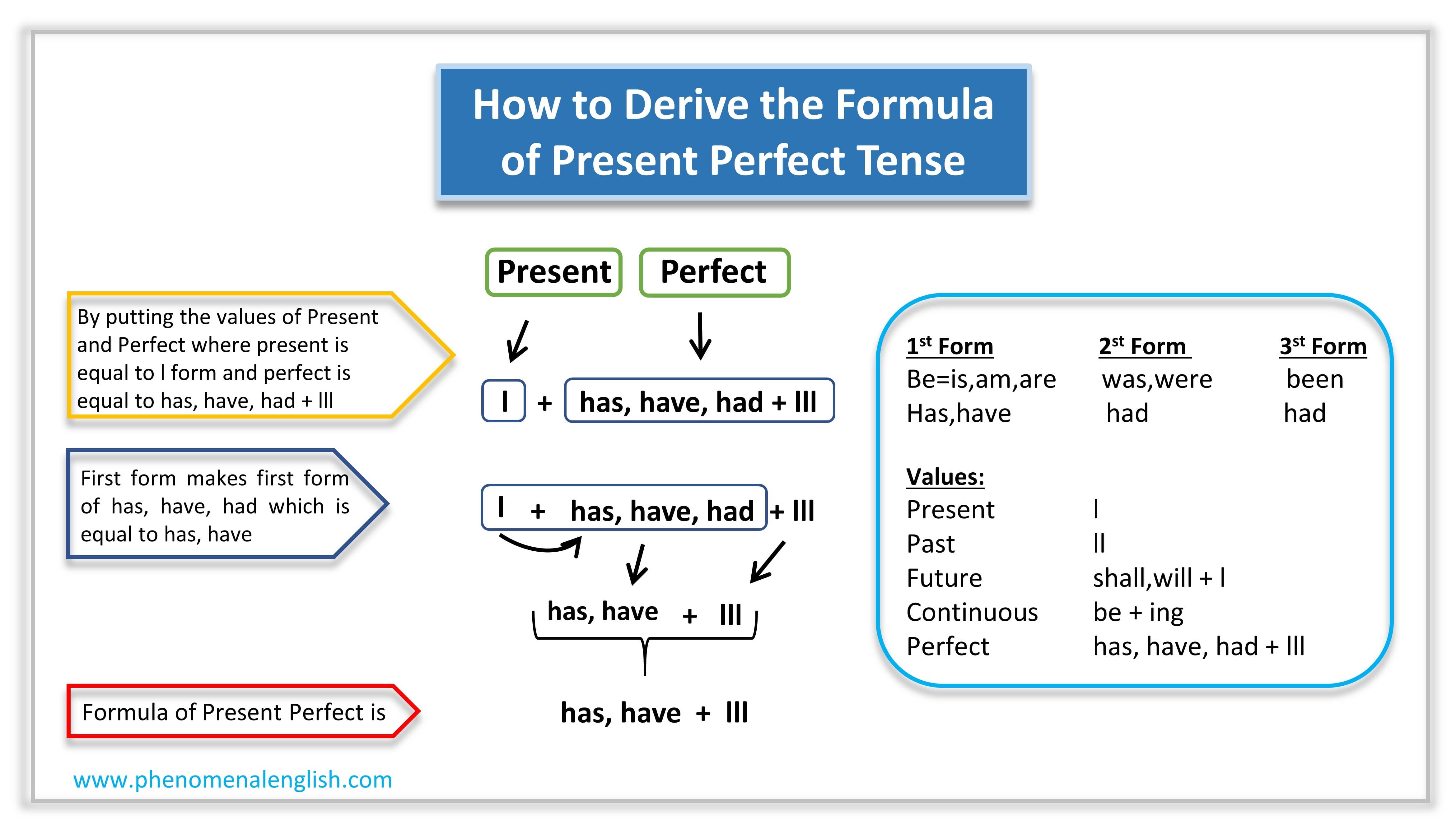

Explanation
We shall put values of present and perfect as are shown in the picture under the values heading where present is equal to 1st form and perfect is equal to has, have, had + 3rd form. In the second step, 1st form will affect has, have, had and it makes 1st form of has, have, had which is has, have. "3rd form" will not be affected by any form so it remains same. In the third step the equation will be "has, have + 3rd" so whole formula will be "has, have + 3rd" which we use for Present Perfect Tense.
Past Perfect
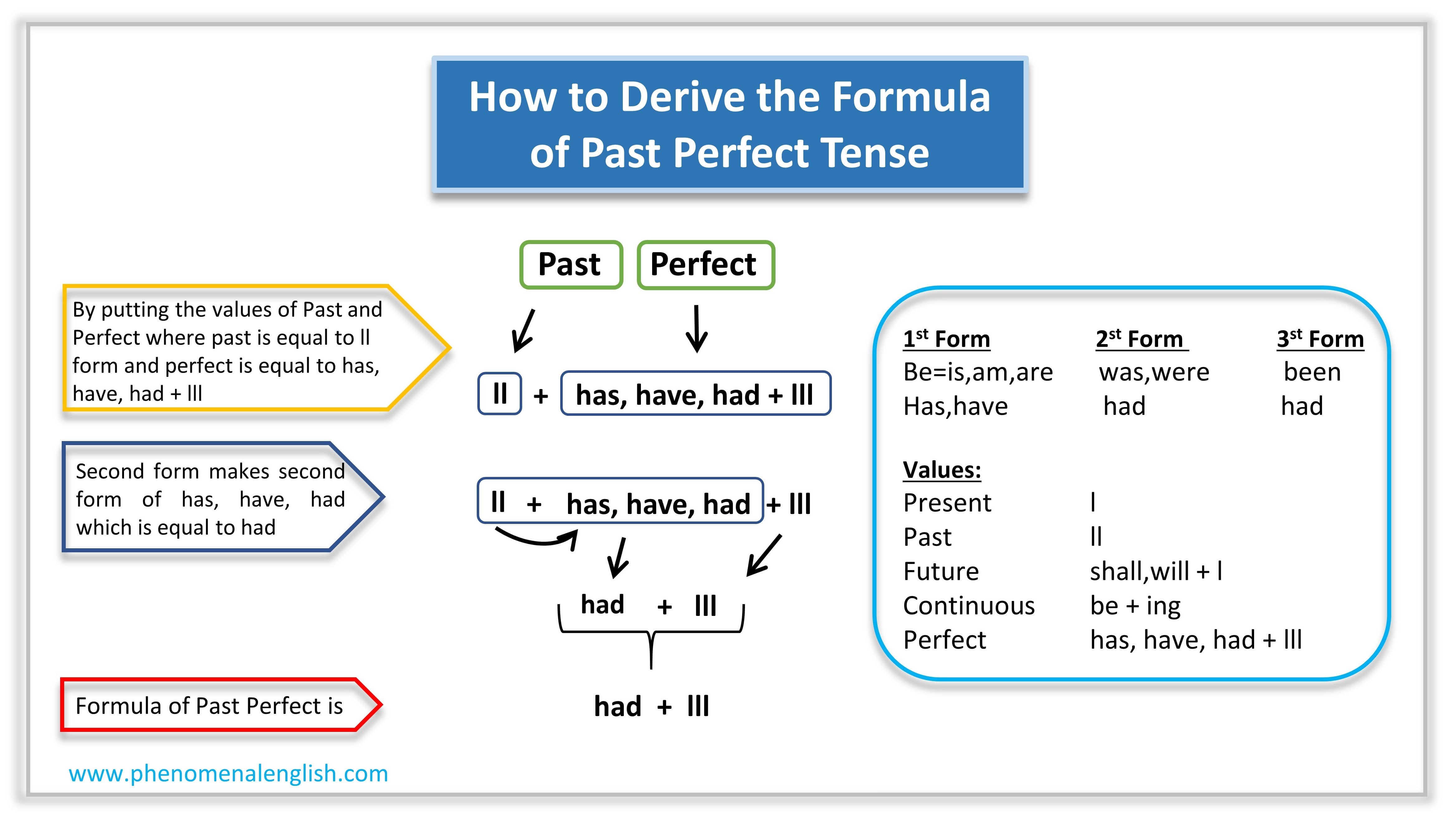

Explanation
We shall put values of past and perfect as are shown in the picture under the values heading where past is equal to 2nd form and perfect is equal to has, have, had + 3rd. In the second step, 2nd form will affect has, have, had and it makes 2nd form of has, have which is had. "3rd form" will not affect anything so it remains same. In the third step the equation will be "had + 3rd". So whole formula will be "had + 3rd" which we use for Past Perfect Tense.
Future Perfect


Explanation
We shall put values of future and perfect as are shown in the picture under the values heading where future is equal to shall, will + 1st form and perfect is equal to has, have, had + 3rd. In the second step, "shall and will" will remain the same and 1st form affects has, have, had and it makes 1st form of has, have, had which is has, have. "3rd form" will not affect anything so it remains same. In the third step the equation will be "shall, will + has, have + 3rd form". shall, will and other modal auxiliaries do not take has after them. So whole formula will be "shall have, will have + 3rd" which we use for Future Perfect Tense.
Present Perfect Continuous


Explanation
We shall put values of present, perfect and continuous as are shown in the picture under the values heading where present is equal to 1st form, perfect is equal to has, have, had + 3rd form and continuous is equal to be + ing. In the second step, 1st form will affect has, have, had and it makes 1st form of has, have, had which is has, have. "3rd form" will affect be and make it been. "ing" will not be affected by anything so it will remain same. In the third step the equation will be "has, have + been + ing" so whole formula will be "has been, have been + ing" which we use for Present Perfect Continuous Tense.
Past Perfect Continuous
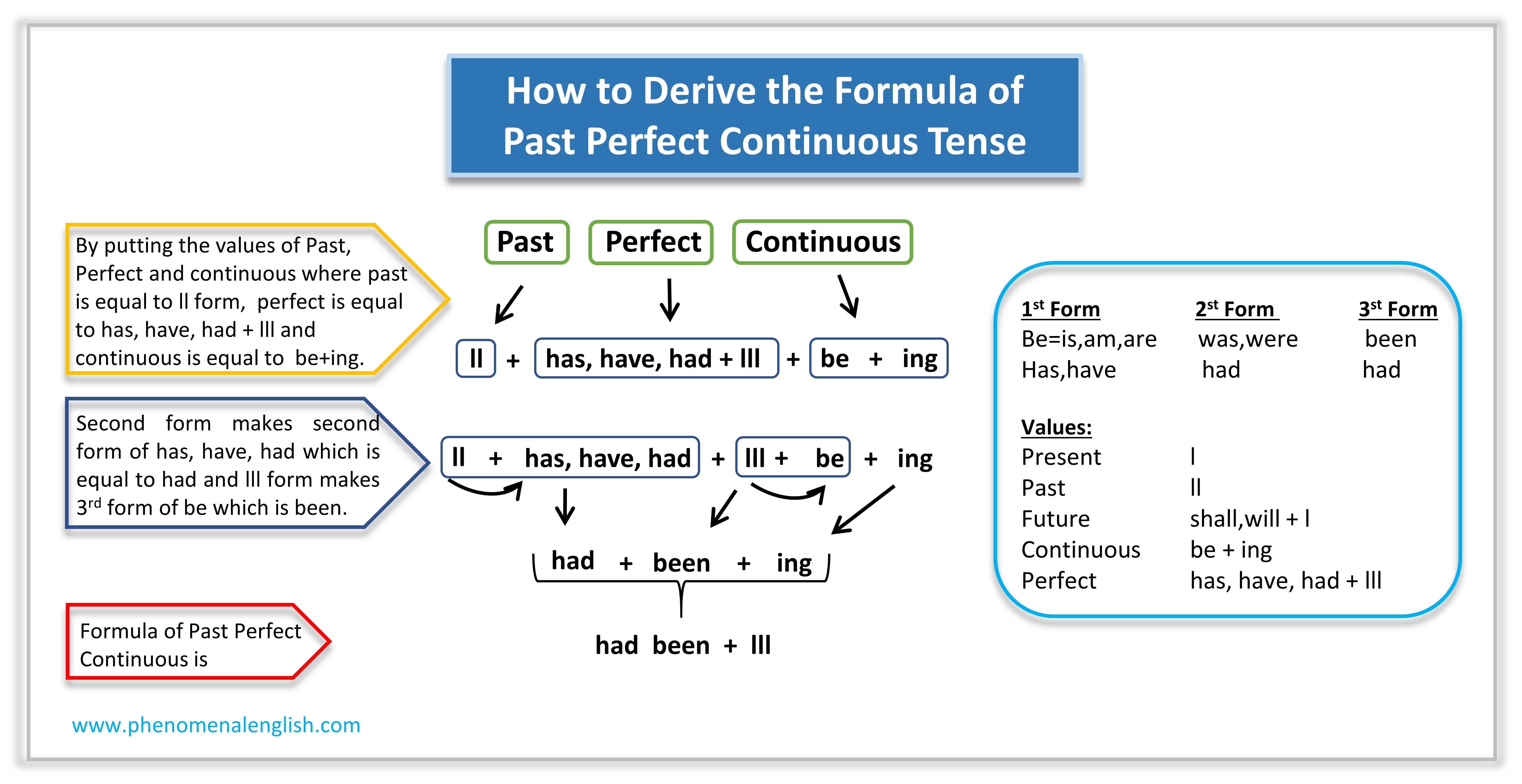

Explanation
We shall put values of past, perfect and continuous as are shown in the picture under the values heading where past is equal to 2nd form, perfect is equal to has, have, had + 3rd form and continuous is equal to be + ing. In the second step, 2nd form will affect has, have, had and it makes 2nd form of has, have, had which is had. "3rd form" will affect be and make it been. "ing" will not be affected by anything so it will remain same. In the third step the equation will be "had + been + ing" so whole formula will be "had been + ing" which we use for Past Perfect Continuous Tense.
Future Perfect Continuous


Explanation
We shall put values of future, perfect and continuous as are shown in the picture under the values heading where future is equal to shall, will + 1st form, perfect is equal to has, have, had + 3rd form and continuous is equal to be + ing. In the second step, 1st form will affect has, have, had and it makes 1st form of has, have, had which is has, have. "3rd form" will affect be and make it been. "ing" will not be affected by anything so it will remain same. In the third step the equation will be "shall, will + has, have + been + ing". shall, will and other modal auxiliaries do not take has after them so whole formula will be "shall have been, will have been + ing" which we use for Future Perfect Continuous Tense.